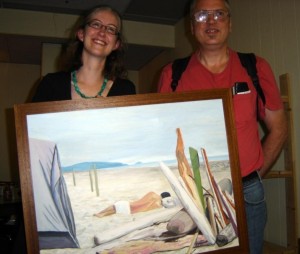
Clive Beal presents one of his paintings to outgoing Community Council Research Director, Jane Worton, at her farewell gathering.
Practicing inclusion is at the heart of the nationally-recognized Quality of Life Challenge, a collaborative initiative led by the Community Council in Victoria, British Columbia. The Quality of Life Challenge seeks to create a sustainable quality of life for everyone in BC’s Capital Region. What follows comes out of a recent conversation I had over coffee with Clive Beal and Christina Peacock, both participants in the Quality of Life Challenge.
Clive is a visual artist; a painter (Check out this profile of Clive’s artistry on Youtube). He also runs gallery space at the Pandora Arts Collective, serves on the Board of the Fernwood Community Association, and employs his machine repair skills as opportunities arise. Oh yes, and he’s also on disability pension and living below the poverty/affordability line! It is these last set of attributes that drew Clive into the Quality of Life Challenge.
Christina is Communications Manager at the Community Council. She is actively involved in convening and supporting many of the Community Council’s collaborative initiatives, of which the Quality of Life Challenge is one.
Practicing inclusion
Individuals with the experience of living on low incomes have important experiences to share. For that reason they were brought in as equal partners to the Quality of Life initiative. Employers, decision-makers, and community leaders can learn from the experiences of people who live on low incomes and make changes within their spheres of influence. Hearing stories directly from those with experience inspires others to take action.
In the following video I made, Clive talks about his role in the Quality of Life initiative, and having his voice heard
(difficulties viewing this embedded video? if so, click here to watch it from YouTube)
Here’s a few of the ways Clive feels included in the Quality of Life Challenge:
- He is given a seat at the table; e.g., Community Action Team Committee
- His voice in the dialogue on issues is welcomed
- His perspectives are actively solicited
- His contributions are acknowledged
- His personal insights are incorporated into collective solutions
- He is asked to share his experiences and expertise with other Committees and stakeholder groups; e.g., by engaging others in the Poverty Experience tool
The way forward
How initiatives are structured is important. Structure influences behavior (see my post on that topic). The Quality of Life initiative is structured so that each participant feels respected, and that they belong. From this safety net, people spring forward with ideas and into action.
Creating a successful collaborative is not easy though. From lessons learned on earlier community development initiatives (e.g., CRUNCH) in the 1990’s, the Community Council established a set of collaboration principles. These principles guided development of a collaborative model, now being applied to the Quality of Life and other local and national initiatives. In this video, Christina places the Council’s work in a broader context
(difficulties viewing this embedded video? if so, click here to watch it from YouTube)
How these collaborative initiatives will evolve going forward is uncertain. Available resources will be attracted to the strongest needs. Yet, whatever emerges will surely have come about through the practice of inclusion. And… I’m sure I’ll remain a big fan of what the Community Council is all about!
Find out more
The (Quality of Life Challenge) Affordability Index reflects the real costs of living, through the hourly wage required to enjoy a modest quality of life in the Capital Region. Read about this year’s living wage calculation here.
For more on Community Council’s practice of inclusion; go here.
What�s your view on inclusion? What do you do to ensure everyone at the table feels included?
If you enjoyed this post, I’d appreciate if you left a comment here and/or subscribed to my RSS feed. Thanks, Ben.


Speak Your Mind